Латышские стрелки в Первой мировой войне
I Первая мировая война
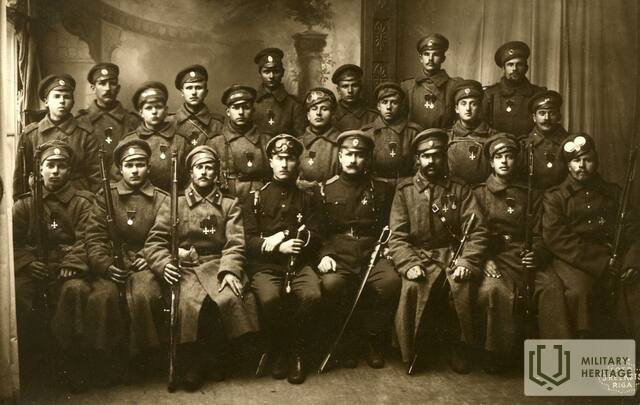
Первая мировая война была поворотным моментом в истории Европы, так было и в истории Латвии. Уже в 1915 году по всей Европе разразилась война, и летом того же года началась история героических латышских стрелков. Тысячи добровольцев в Латвии присоединились к армии и создали свои национальные отряды. Тысячи мужчин хотели добровольно противостоять врагу бок о бок со своими соотечественниками.
Весной 1915 года на территорию Латвии вторглись немецкие войска, и после почти полугодовой войны фронт стабилизировался, разделив Латвию на две части. Река Даугава стала линией фронта и символической границей, на берегах которой осталось много родных домов и родственников. Героическими предшественниками латышских стрелков были два сводных батальона Даугавгривской крепости, которые вели тяжелые бои против вторгшихся немцев.
К весне 1915 года русские военные власти получили несколько предложений о создании латышских национальных воинских частей. Однако все они были отклонены. После успешных боев батальонов Национальной гвардии Даугавгривской крепости под Елгавой в начале мая 1915 года вновь возникла мысль о необходимости латышских воинских формирований. За него высказался один из самых видных латвийских политиков того времени - Янис Гольдманис, депутат Государственной Думы России. Для обсуждения этой идеи и возможностей ее реализации 1 июня 1915 года он пригласил на тайное совещание видных представителей латышской интеллигенции, военных и экономических кругов.
Катастрофическое положение русской армии летом 1915 года было одним из важнейших факторов в получении благоприятного решения о формировании латышских частей, перспективного латышского командного языка, латышских надписей на боевых знаменах и особых нагрудных значений. Оставались и надежды на политические реформы после окончания войны — введение более крупного местного самоуправления в Латвии, административную реформу и культурную автономию.
10 августа 1915 года в газете «Дзимтенес Вестнесис» было опубликовано приглашение, написанное писателями Атой Кениньшем и Карлисом Скалбе и подписанное депутатами Государственной Думы России Янисом Гольдманисом и Янисом Залитисом, дружить и защищать свою Родину от немецких захватчиков.
В первые дни приехало так много мужчин, что оргкомитеты работали даже ночью. Среди добровольцев было много молодых людей, не испытавших ни войны, ни службы, но их энтузиазм привлекал и мужчин постарше, которые знали, куда идут. Всего подали заявки около 8000 добровольцев, а в латышских стрелковых батальонах на протяжении всей Первой мировой войны насчитывалось до 25000 человек. До 1916 года латышские стрелки объединялись в Даугавгривский батальон, Рижский, Курземский, Видземский, Земгалеский, Тукумский, Бауский, Валмиерский и Резервный батальоны, которые в последующие годы войны были переименованы в полки.
В первые бои латышские стрелковые батальоны вышли в октябре 1915 года, чтобы остановить немецкое наступление на Ригу. Летом и осенью 1916 г. стрелки сражались на Острове Смерти;
После окончания Первой мировой войны часть латышских стрелков осталась в России и сражалась в Гражданскую войну по разные стороны фронта, часть участвовала в Борьбе за свободу в Латвии. В 1920 году, с наступлением мирного времени, в Латвию вернулось большое количество бывших стрелков, проведших последние пять лет на войне.
Из примерно 3000 латышских стрелков, павших до 1917 года, 870 похоронены на Рижском братском кладбище. По другим причинам их не удалось перевезти в Ригу, поэтому захоронения латышских воинов можно найти в Слоке, Кемери, Тинужи, Кекаве и других местах.
Помимо событий Первой мировой войны, в Латвии была фактически и другая борьба - борьба за самоуверенность латышей, и в то время из духа стрелковая борьба.
Дополнительные источники информации
1. Документальный фильм «Под флагами Латвии. Рождение героев», 2015. Режим доступа: https://www.youtube.com/watch?v=GmZV74r6EbI [дата обращения: 05.04.2021].
2. Вьюга душ. Цифровой музей. Доступно: https://www.dveseluputenis.lv/lv/laika-skala/notikums/67/latviesu-inteligence-nolemj-dibinat-strelnieku-vienibas/ [дата обращения: 05.05.2021].
3. Зариньш К. «Первая мировая война в Латвии и бойцы латышских стрелков», 2015. Доступно: https://www.sargs.lv/lv/pirmais-pasaules-kars/2015-07-15/pirmais- pasaules-kars-latvia-and-latvian-strelnieku-cinas [просмотрено: 05.05.2021.].
Ваши комментарии
Связанная хронология
Связанные объекты
Музей Pождественских боев и выставка под открытым небом
Мемориальный парк и музей Рождественских боев находится в Валгундской волости Елгавского края, в домах «Мангали». Музей является филиалом Латвийского военного музея, он был открыт в 2005 году и находится на территории, где проходили Рождественские бои. В местах сражений до сих пор сохранились уникальные укрепления времен Первой мировой войны. В экспозиции музея представлены предметы, найденные на полях сражений.
Восстановленные укрепления можно увидеть в рамках экспозиции под открытым небом. Рядом с музеем проложены туристические маршруты и образовательные тропы. Экспозиция фортификаций и выставок времен Первой мировой войны под открытым небом открыта для посетителей каждый день. В окрестностях Ложметейкалнса сохранились уникальные свидетельства укреплений времен Первой мировой войны. Здесь находится смотровая башня высотой 27 м, с которой открывается панорамный вид на места Рождественских боев. Рождественские бои, пожалуй, самое известное и драматичное событие Первой мировой войны в Латвии. Оно занимает особое место в военной и культурной истории Латвии. Бои в основном связаны с нападением латышских стрелков на части немецкой армии, которое проходило в особо тяжелых и неблагоприятных условиях. Небывалый случай, чтобы крупномасштабная боевая операция начиналась без артиллерийской поддержки.
Речные траншеи
Первый этап маршрута проходит по центру долины реки на автобусной остановке.
Утром 1 сентября 1917 года после трехчасового артиллерийского огня немцы начали строительство трех деревянных понтонных мостов через Даугаву в районе Икшкиле. Было произведено около 560 000 выстрелов из 1159 орудий и минометов, которые полностью подавили 66 русских орудий и вынудили 186-ю дивизию отступить на правый берег Даугавы. Командующий 12-й русской армией генерал Парскис приказал 43-му корпусу нанести контрудар на прорыве и передал командующему корпусом 33-ю, 136-ю, 138-ю дивизии, 116-ю дивизию и 2-ю латышскую стрелковую бригаду.
Днем 1 сентября латышским стрелкам было приказано вести бой с немцами, переправившимися через Даугаву. 2-я латышская стрелковая бригада из Ропажи пошла навстречу атакующим немецким частям, а бойцы 5-го Земгальского латышского стрелкового полка около четырех часов дня вышли к укрепленным позициям на правом берегу реки Малая Югла. После артиллерийского огня в середине 2 сентября началась атака позиций латышских стрелков. Оборонительные бои шли на фронте протяженностью 14 км по правому берегу Малой Юглы. Солдаты 2-й Латышской стрелковой бригады с несколькими пушками противостояли численно и технически более сильной группировке немецких войск, которые также использовали в атаке авиацию, огнеметы и снаряженные пушечными гранатами. Стрелкам удалось героически удерживать фронт в течение 26 часов до 3 сентября. Выполнив свою задачу, уцелевшие латышские солдаты по приказу командования 12-й армии ушли на позиции Сигулды и Цесиса. Потери были очень тяжелыми — 5-й Земгальский и 6-й Тукумский латышские стрелковые полки выбили более половины бойцов, меньше пострадали 7-й Бауский и 8-й Валмиерский латышские стрелковые полки.
Центр культурного наследия «Поместье Тинужу» («Tīnūžu muiža»)
Центр культурного наследия «Tīnūžu muiža» находится в Огрском районе, в селе Тинужу, в 7 км от городов Огре и Икшкиле. Первые письменные сведения о поместье относятся к 16-му веку. До середины 18-го века поместье считалось хозяйственным производством небольшими постройками. Со временем оно превратилось в крупное хозяйство. Во время Первой мировой войны в этом районе между русской и немецкой армиями происходили бои, в которых сражались и латышские стрелки. Во время войны за независимость в поместье Тинужу располагались штаб 1-го Валмиерского пехотного полка Латвийской армии и парк бронированных автомобилей. В 1932 году поместье было передано Латвийскому союзу инвалидов войны, который обеспечивал их жильем и заботился о ветеранах. Во время Второй мировой войны, в 1943 году в поместье Тинужу из Эстонии была переведена немецкая армейская часть «FAT 212». Это была группа фронтовых диверсантов, готовивших солдат к борьбе с Красной Армией.
Латвийских солдат также обучали разведке, тактике партизанской войны и саботажу. Хозяйский дом поместья Тинужу был разрушен, когда Красная армия пошла на Ригу. Сегодня вы можете увидеть выразительный пейзаж с историческими зданиями на берегу реки Маза Югла. Выставки, посвященные историческим событиям, в том числе о латышских стрелках, можно увидеть в Центре культурного наследия «Поместье Тинужу».
Памятник битве на Малой Югле в Тинужи
Находится в Икшкильском районе, в селе Тинужи, у шоссе возле Тинужской основной школы.
Мемориал латышским стрелкам, сражавшимся против немецкой армии во время Первой мировой войны. Сражение на реке Малая Югла 1-2 сентября 1917 года стало кульминацией Рижской операции. Немецкая армия начала наступление на Икшкиле с целью овладеть Ригой и взять в плен 12-ю русскую армию. Части немецкой армии, переправившись через Даугаву по понтонным мостам, вышли в район реки Малая Югла, где были блокированы латышскими стрелками. Им было приказано задержать противника до тех пор, пока вся русская 12-я армия не выйдет из осады, не попав в плен к немецкой армии. Боевые действия наносят тяжелый урон обеим воюющим сторонам.
Сегодня вы можете увидеть памятник скульптору Янису Карлову «Алтарь героев», который был открыт в 2005 году и будет посвящен латышским бойцам. Усадьба Тинужи, где расположена выставка, находится в 300 метрах.
Пулеметный холм
Расположен в Елгавском крае, недалеко от автомагистрали A9.
Ложметейкалнс – место боевых действий Первой мировой войны, единственный в Латвии культурно-исторический заповедник государственного значения. Он расположен на Длинной дюне, которая является частью гряды дюн Нордеки – Калнциемс. Название пулеметной сопки возникло в то время, когда здесь находились труднодоступные укрепления немецкой армии, которые оборонялись сильным пулеметным огнем.
Рождественские сражения, пожалуй, самое известное и драматичное событие Первой мировой войны в истории Латвии. Он занимает особое место в военной и культурной истории Латвии. В 1917 году латышские стрелковые и сибирские части русской армии напали на Ложметейкалнс и заняли его. Было взято в плен не менее 600 противников, а также ценные трофеи, такие как 19 пулеметов. Это был самый значительный успех Рождественских боев и самый большой выигрыш, которого добились русские войска на Рижском фронте. Латышские стрелки считали, что заслужили честь покорителей горной местности.
Сегодня здесь находится смотровая башня с видом на бывшие сражения. Мемориалы и свидетельства военного времени можно увидеть в этом районе. Рядом находится кладбище братьев Силениеки.
Мемориал рождественских сражений на Братском кладбище Антину
Находится в Бабитском районе, на обочине дороги, недалеко от бывшего дома Антини и склада старых лекарств.
Кладбище солдат Антини или Тирели было основано во время Первой мировой войны. В этом районе располагались оборонительные позиции армии Российской империи. В 1917 году, во время Рождественских боев, рядом располагался штаб 5-го Земгальского латышского стрелкового полка и лазарет со складом медикаментов.
В ночь на 5 января 1917 года при свете восьми огромных костров с воинской честью были похоронены 105 бойцов 5-го Земгальского Латышского стрелкового полка. Они пали в боях с немецкой армией или умерли от ран. Церемонию похорон возглавил командир полка Юкумс Вациетис. В последующие годы на кладбище хоронили и воинов других частей русской армии. В 1925 году на кладбище был открыт памятник архитектору Эйзену Лаубе, благоустроена территория. Информацию о захороненных на кладбище 3800 воинах можно найти во многих местах, но ее следует оценивать как маловероятную и непроверенную.
Второй памятник воинам первой независимой Латвии в Марупе
находится в Марупском районе, перед зданием гольф-клуба «Виестури» на лесной дороге, напротив указателя на тренировочную площадку для гольфа.
Авторами идеи проекта являются экскурсовод Марупского края Микелис Якуновс и владелец земельного участка «Думмали» Висвалдис Думпис.
В ноябре 2014 года, в рамках недели латышских патриотов, в честь латышских воинов в лесу близ Дзилнупите, на границе Марупского и Бабитского уездов, на одном из мест сражений Первой мировой войны, был открыт второй памятник латышским воинам. Война. Автор концепции и финансист памятников – Висвальдис Думпис, их создал скульптор Иварс Фельдбергс. Владелец мемориала Висвалдис Думпис хотел бы, чтобы люди собирались здесь не только 14 июня и 25 марта, но и 10 июля, в годовщину основания сил обороны, и в другие важные для латышей исторические события.
9 ноября 2018 года возле памятника открылся информативный стенд об истории места и достопримечательностях. Он посвящен истории места, рассказывая о существовавших здесь когда-то домах «Адиень» и жившей там семье Курбья, о событиях Первой мировой войны в этом районе, а также об исторических объектах, которые больше не могут быть увиденное на природе - Дучий мост, Дзирнавский пруд и мельница, Охотничьи купальни.
Бывший медицинский склад латвийских солдат
Находится в Бабитском районе, недалеко от солдатского кладбища Антини и отреставрированных траншей.
Во время Первой мировой войны с 1915 года в этом районе располагались оборонительные позиции армии Российской империи. В 1917 году, во время Рождественских боев, в доме Антини находился штаб 5-го Земгальского латышского стрелкового полка и лазарет со складом медикаментов, которым руководил выдающийся латышский военный врач Петерис Сникерис.
В ходе Рождественских боев атаки латышских стрелков на части немецкой армии проходили в особо тяжелых и неблагоприятных условиях. Ранения, полученные в ходе боевых действий, были всех видов - раны, контузии и травмы, нанесенные огнестрельным оружием, а также обморожения. Тысячи латвийских солдат нуждались в своевременной медицинской помощи. Она была организована таким образом, чтобы пострадавшим была оказана помощь как можно скорее. На поле боя находились невооруженные фельдшеры, которые оказывали первую помощь и выносили раненых из опасных мест. Вблизи полей сражений были устроены перевязочные пункты, где продолжался уход и производилась сортировка. Раненых солдат эвакуировали в госпитали или госпитали на подводах и автомобилях. Рядом с Лазаретом были устроены кладбища, где хоронили умерших.
В настоящее время вы можете увидеть старый магазин медицины. Неподалеку находится Солдатское кладбище Антини, а также окопы и блиндажи времен Первой мировой войны. Среда подходит для прогулок по лесу, раскрывая яркие свидетельства военного наследия.
Исторический исследовательский маршрут Первой мировой войны и землянка
Расположен в Олайне, недалеко от Олайнского историко-художественного музея.
Исторический маршрут был проложен в 2018 году на месте укреплений русской армии времен Первой мировой войны, входивших в систему обороны местности. Боевые действия между немецкой и русской армиями в районе Олайне привлекают внимание по нескольким причинам. Болотистая местность мешала воюющим сторонам быстро продвигаться вперед и требовала от солдат различных навыков для действий в неблагоприятных условиях. Важную роль в войне сыграли точный анализ местности, разведка, фортификационные или инженерные сооружения.
В настоящее время познавательный маршрут находится в свободном доступе и дает примерное представление об условиях жизни солдат. Отреставрированные здания закрыты, но их можно увидеть, предварительно связавшись со специалистами Олайнского историко-художественного музея.
Остров Смерти
Группа островов расположена в Даугаве, на южной стороне водохранилища Рижской ГЭС, ближе к Даугмале. Остров Смерти - одно из самых страшных и легендарных полей сражений Первой мировой войны. В 1915 году, когда русская армия отступила из Курземе и Земгале, некоторые части остались на левом берегу Даугавы, где они заняли позиции для борьбы с немецкой армией. Берега реки были соединены мостом. Здесь произошел один из самых крупных случаев применения химического оружия на территории Латвии. Латышские солдаты прозвали это место «Островом Смерти», а солдаты других национальностей - «адом». Позиции на Острове Смерти имели стратегическое и символическое значение. Для латвийских солдат это была часть оккупированного немцами Курземе. Бои происходили на берегу Даугавы возле Икшкиле, и в сознании они ассоциировались с боями предков во время крестовых походов. В настоящее время сюда можно добраться на лодке. Видна незатопленная территория водохранилища Рижской ГЭС. Сохранился памятник, спроектированный Э. Лаубе. Кое-где реконструированы элементы оборонительных позиций. Информационный стенд находится на берегу Даугавы у холма Кабелю в Икшкиле. Остров Смерти стал группой островов после строительства водохранилища Рижской ГЭС.
Огрский историко-художественный музей
Огрский историко-художественный музей был создан в 1981 году. Коллекция музея насчитывает более 40 тысяч различных единиц, полученных на территории города Огре и бывшего Огрского района. Он широко изображает культурное и историческое наследие, начиная с древних времен и до наших дней.
На выставке «От банка к музею» посетители могут ознакомиться с историей здания на улице Бривибас, 36 и его трансформацией за 50 лет. Первоначально построенный как банк СССР, в последнее время он стал домом Огрского историко-художественного музея.
Экспозиция «Отдыхники в Огре» посвящена одной из самых ярких и легендарных страниц истории города. Он показывает возможности отдыха, развлечения отдыхающих, а также легенды, оплетающие культурную и общественную жизнь Огре с начала 20 века до Второй мировой войны. История жизни Огре как города-курорта представлена тщательно отобранными документами и предметами, а также их привлекательной художественной подачей.
Выставки в музее меняются ежемесячно. Тематические выставки, как правило, посвящены различным историческим событиям, но на художественных выставках представлены художники, керамисты, графические дизайнеры, фотографы и представители других творческих профессий из Огрского муниципалитета и всей страны.
Коллекция военных велосипедов в Саулкрастском (Saulkrasti) музее велосипедов
Музей велосипедов находится в Саулкрасты, недалеко от Белой дюны, автомагистрали А1 и железнодорожной станции «Пабажи». Коллекция музея основана на наиболее интересных с технической точки зрения примерах из истории развития велосипедов, найденных в Латвии. Это самая большая коллекция велосипедов в странах Балтии, которая насчитывает около 60 велосипедов произведенных и используемые в Латвии, включая велосипеды армейского образца. В начале 20-го века наличие и преимущества велосипедов стали широко использоваться в армии. Для быстрого передвижения были созданы специальные велосипедные отряды. Велосипедисты легче вели разведку, неожиданно атаковали противника и были более маневренными на обширной территории, чем пехота. После Первой мировой войны в Латвийской армии также были велосипедные подразделения с армейскими велосипедами латвийского производства. Солдат, входивший в состав велосипедного отряда, должен был соответствовать строгим требованиям. Он должен был быть сильным, с хорошим зрением, слухом, здоровым сердцем и легкими. Вес не менее 80 кг, рост 165-180 см.
В латвийской армии было требование, что хорошо подготовленный велосипедист должен преодолевать 80–100 км в течение дня, а форсировано - до 150 км. Зимой, когда нельзя было ездить на велосипедах, ходили на лыжах. Велосипедист должен был уметь пройти на лыжах 50-60 км в день. Многие военные велосипедисты стали профессиональными спортсменами.
Землянки Саулкрасты
Расположен в Саулкрасты, в прибрежных дюнах возле ресторана "Лагуна".
Укрепления русской армии были построены во время Первой мировой войны для защиты побережья от десантных операций немецкой армии. Он является частью фортификационной системы охранного района, который располагался в непосредственной близости от стратегически важных объектов.
Во время Первой мировой войны русская армия установила на территории Латвии несколько линий обороны. В случае прорыва одного из рубежей новые позиции и дополнительные силы помешали бы продвижению немецкой армии вперед. Одна из линий располагалась в зоне, которая начиналась в Саулкрасты, продолжалась в Лигатне, Нитауре и заканчивалась в Кокнесе, соединяясь с первой линией обороны, протянувшейся вдоль берега Даугавы. Цель состояла в том, чтобы укрепить территорию вокруг Саулкрасты, так как там было много важных объектов. Несколько переходов через реки, разветвленная сеть дорог, ведущая в середину Видземе, а также защитные позиции, выходящие на берег моря.
Сегодня на этом месте есть траншеи в красивом приморском лесу с видом на море. Это одна из достопримечательностей в широком спектре туризма Саулкрасты.
Памятник Свободы в Риге
Он находится в центре Риги, на площади Бривибас.
Памятник Свободы – один из самых выдающихся памятников истории, архитектуры и искусства Латвии. Он был построен по проекту Карлиса Заалеса на общественные пожертвования. Открыт в 1935 году как символ свободы и любви латышского народа к отечеству. Вместе с ансамблем Могилы рижских братьев он относится к ценнейшим образцам монументальной архитектуры и скульптуры.
Памятник Свободы выражает этические и эстетические ценности латышской культуры. Символы отражают философскую природу свободы и исторические представления латышского народа об этапах борьбы за независимость. Указывает на воплощение физической и душевной силы. Героический язык рассказывает о латышском народе как о самостоятельном, активном творце истории и вершителе своей судьбы.
На его месте изначально стоял памятник русскому царю Петру I. В Первую мировую войну его разобрали для перевозки на корабле в Петроград. Корабль был торпедирован немецкой подводной лодкой и затонул у острова Вормс на территории Эстонии. Советский оккупационный режим несколько раз планировал снести памятник Свободы, но этого не произошло.
Сегодня здесь можно увидеть один из символов Латвии и понаблюдать за традициями армейского почетного караула.
Мемориальная комната генерала Карла Гоппера в родном городе Маскат
Находится в волости Плани на берегу реки Вия.
Видна мемориальная комната генерала Карла Гоппера в его родном доме «Мускат».
Фермой Маскат управлял брат генерала Август Гопперс, потому что талантливый военачальник был занят крупными событиями и мировыми войнами. В 1920 году генерал вернулся в Латвию, в родной дом. Но с Ригой его связывало множество ответственных обязанностей. Август продолжал работать в Маскате. В 1940 г. генерал Гоппер был арестован и 25 марта 1941 г. расстрелян в кассовом подвале. В 1944 году семья Гоппер отправилась в Курземе в качестве беженцев на трех конных повозках. Война разделила семью, дочери Александра Гоппера — Бирута, Эльза и Анна — остались в Латвии. Им не разрешили вернуться в Маскат. Дома были большими и тщательно охранялись. Три четыре семьи новоприбывших были размещены в отдельных комнатах. В большом амбаре была устроена конная ферма. В 1980 году вспыхнул пожар из-за взаимной чесотки. Сарай и большой амбар сгорели. К счастью, огонь не перекинулся на дом, пламя отбивали большие деревья, посаженные нашими предками.
В 1991 году после чудесного Пробуждения во второй раз возродилось Латвийское государство. В 1992 году семья брата генерала Гоппера Августа вернула Маскат как исконную святыню. В течение десяти лет вся сыроварня усердно трудилась, чтобы спасти дома от разрушения, восстановить и возвести разрушенные постройки, чтобы вся ферма Маскат стала красивой. Дома восстановлены в прежнем виде, а также есть мемориальная комната генерала Карла Гоппера, посетить мемориальную комнату можно заранее по телефонам +371 29396870, +371 29254285.
Экскурсия к памятнику воинам, погибшим в Первую мировую войну в парке усадьбы Спаре.
Находится на территории усадебного комплекса Спаре.
Во время Первой мировой войны в поместье Спаре располагался полевой лазарет русской армии. На близлежащем кладбище похоронены 24 погибших солдата, в том числе латышские стрелки. Памятник был открыт 6 октября 1935 года.
Во время памятного места (начиная от дороги) по обеим сторонам дороги были посажены ряды лип. В 1935 году все работы по благоустройству территории выполняли ученики Спаре под руководством директора школы Карлиса и Алвине Скалбергс.
Учащиеся Спареской начальной школы Аматского района также участвуют в очистке мемориала. Огромную поддержку в этих работах оказывает земская охрана Цесисского 27. КБ.
Факельное шествие к мемориалу павшим в Первой мировой войне, которое проходит 11 ноября, стало традиционным. На этом мероприятии всегда толпятся охранники Цесисского 27. КБ, с ними всегда капеллан. Праздничные залпы – неотъемлемая часть мероприятия.
На территории усадебного комплекса Спаре экскурсия к памятнику воинам, павшим в Первой мировой войне (45 мин.) предлагается по предварительной договоренности по телефону +371 26558464.
Памятный камень латышским стрелкам в Плаканциемсе
В Плаканциеме латышские стрелки одержали свою первую победу в историческом ночном бою 29 октября 1915 года - всего через неделю после того, как 1-й Даугавгривский батальон латышских стрелков покинул Ригу и начал действовать на фронте. Успешное сражение у Плаканциемса положило начало героической борьбе наших стрельцов. Неоценимое моральное значение имела и ночная атака у реки Миса — боевые способности латышских стрельцов никто не ставил под сомнение, они быстро стали популярными и многие латыши из русских полков перешли в наши национальные части.
Памятный камень изготовлен по заказу самоуправления Кекавского района Кекавским районным предприятием по обработке и реставрации камня "Akmens prāvaškas centrs "AKM"" - мастерами по камню Гунтисом Пандарсом и Петерисом Зваунисом.
Успех в битве при Плаканциемсе был обеспечен тщательной непрерывной четырехдневной разведкой, внезапным планом атаки, подготовленным командиром 1-й роты Фридрихом Брижем, и героизмом наших солдат.
Обстановка на фронте в это время была очень напряженной, так как немецкие солдаты в ряде мест продолжали медленно приближаться к Риге. В районе Плаканциемса они недавно форсировали реку Миса и начали обустраивать позицию переднего моста, развернув 2-й батальон немецкого 376-го пехотного полка и 4 пулемета.
Атака латышских стрельцов основывалась на внезапности, быстроте действий и координации различных действий. Каждому стрелку 1-й роты выдали по четыре ручные гранаты, 60 солдат надели свои белые халаты, потому что только что выпал тонкий снежок. Когда наступающие подобрались достаточно близко к немецким позициям, в 22.00 был дан сигнал и началась атака. Оба наших пулемета вели огонь по обоим флангам противника, так что немцы не могли подтянуть резервы. Бросая ручные гранаты, латышские стрелки стремительно штурмовали немецкие окопы, русские артиллеристы обстреливали мост через реку Миса и главную полосу обороны противника. Солдаты противника были в замешательстве - понеся большие потери, они отступили за реку и оставили плацдарм в руках наступающих. Одна из наших рот разбила вражескую часть в четыре раза больше!
Латвийские лучники потеряли шестерых павших - Юрия Бутениека, Фричи Армани, Рудольфа Хофмани, Кристапса Круминю, Яниса Наури и Кирияна Шнурова. Все они похоронены на Рижском Братском кладбище. Из восьми раненых двое позже скончались - Язепс Бруверис (похоронен на Плескодалском кладбище) и Янис Скуя (похоронен на кладбище Рижских братьев). Потери немцев – 31 солдат убитыми, 34 пленными и 45 ранеными. В качестве трофеев нападавшие получили пулемет и 35 винтовок.
Памятник воинам, погибшим в Первой мировой войне и Освободительной войне Латвии.
Расположен на улице Базницас, напротив костела Святой Анны.
Можно увидеть памятник воинам, погибшим в Первой мировой войне и Освободительной войне Латвии.
1 мая 1923 года напротив Мазсалацкой лютеранской церкви была посажена «Роща героев», где каждому павшему был посвящен дуб. По словам Лайкерта, всего было посажено 97 дубов — 23 для павших в Войне за независимость и 74 для павших в Первой мировой войне. Однако тогдашняя пресса упоминала, что было посажено 106 дубов.
21 августа 1927 года на площади Героев был открыт бетонный памятник архитектора Паулса Кундзиньша, в строительстве которого также участвовал скульптор Вильхельмс Трейс.
Памятник находится рядом с церковью Св. Анны в Мазсалаце, которая построена в специально отведенном для горки месте (58,6 м), красивую башню видно издалека. Церковь хорошо сохранилась, так как в советское время ее не разрушали и не приспосабливали для каких-либо других целей.
Могилы братьев латышских лучников
Он расположен недалеко от православной церкви Нитауре, рядом с II. для мемориального ансамбля воинам Советской Армии Великой Отечественной войны.
2 сентября 1934 года были освящены могилы стрелков и неизвестных солдат, павших в столкновении с немцами под Нитауре в сентябре 1917 года.
Хронологический порядок сооружения могил:
В сентябре 1917 г. линия фронта была укреплена на участке Саулкрасты-Лигатне-Нитауре-Лобес эзерс (близ Крапы)-Кокнесе. На дороге Малпилс-Пельни-Нитауре 6-й Тукумский и 5-й Земгальский полки вступили в последний бой с противником - немецкими войсками. Об этом сказал полковник Юкумс Вяэтис:
«После этого боя на фронте наступило затишье».
Погибших хоронили возле православной церкви в Нитауре и в различных местах столкновений на участке Малпилс-Пельни-Нитауре.
Газета «Латвияс карейвис» за 1922 год. 21.11.05 в статье «Исторические боевые памятники» упоминается, что «Могилы братьев латышских стрелков до сих пор находятся в Нитауре, где также происходили столкновения с немцами».
17 июля 1929 года в Нитаури выехала комиссия для осмотра захоронений и обнаружила, что в Нитаури возле православной церкви похоронено около 100 солдат русской армии (вы должны знать, что латышские стрелковые полки были созданы в составе русской армии), а рядом с лютеранской усыпальницей похоронено 6 латышских стрелков: Отто Берзиньш (5-й Земгальский стрелковый полк), Карклиньш (6-й Тукумский стрелковый полк), Альфредс Бедритис (пал под Цесисом в Освободительной битве 1919 г.), Свилюмс (лучник ), Жанис Крутайнис (5-й Земгальский полк) и неизвестный латышский солдат.
В 1933 году стрельцы, похороненные возле дома Пелни, были перезахоронены на Малпилсском кладбище, а останки солдат, павших местами в Морской волости, были перенесены на кладбище братьев Нитауре возле православной церкви Нитауре. Здесь же перезахоронили 6 павших воинов, похороненных на лютеранском кладбище.
В фондах Цесского музея хранится фотография неизвестного автора, на которой изображены могилы братьев в Нитауре до Второй мировой войны. мировая война.
После II. Во время Второй мировой войны на этих кладбищах хоронили советских воинов, погибших в боях под Нитаурой и Море, и убрали все свидетельства того, что здесь находились могилы братьев-латышских стрелков. В 1984 году был создан видимый ныне мемориальный ансамбль советских воинов или красноармейцев.
Таким образом, мемориальное место латвийских бойцов было стерто с лица земли.
В 2017 году благодаря инициативе и работе Даце Эйпурес, краеведа и экологического гида Нитауре, на территории могил старых братьев был создан новый мемориал.
Ознакомиться с историей мемориала и Первой мировой войны в Нитауре можно в программе экологического гида Даце Эйпуре «Латвийские исторические приключения в Нитауре», предварительно позвонив и записавшись на посещение +371 29156765!
Кладбище Цесисских братьев
Находится на Цесисском кладбище Леяс, улица Ленчу 15, Цесис.
Одним из важнейших памятных мест Первой мировой и Освободительной войны в Цесисе является Братское кладбище на Нижнем кладбище.
Кладбище является памятником Братского кладбища, построенным в 1927 году цесисским художником и мыслителем Аугустусом Юллой (1872-1958), посвященным солдатам, похороненным на Братском кладбище с 1915 по 1920 годы.
На братском кладбище Цесисского Нижнего кладбища похоронено около 200 воинов. Среди них неизвестное количество латышских стрелков и русских солдат, погибших в Первую мировую войну, а также солдаты немецкой (10), польской и других национальностей. Во время Латвийской освободительной войны на этих кладбищах были похоронены 22 павших солдата 5-го (2-го) Цесисского пехотного полка, а также 11 борцов за свободу, павших в других частях латышской армии. На Братском кладбище похоронены 2 эстонца, 15 жертв большевиков, а также латышские красные стрелки.
Выставка Цесисского (Cēsis) музея истории и искусства в Новом замке
Цесисский музей истории и искусства расположен в самом центре Старого города Цесиса – в Новом замке. В музее действует постоянная экспозиция истории и интерьеров «Цесис - символ истории Латвии», состоящая из двух тематических частей: Экспозиция «Красно-бело-красный флаг в истории Цесиса и Латвии» знакомит с историей создания национального флага Латвии с 13 по 20 век, утвержденного как национальный символ, а также флагами батальона Латышских стрелков и традициями использования национальных цветов во время войны за независимость Латвии
Экспозиция «Борьба за свободу Латвии и Цесиса» рассказывает о формировании Цесисской роты в декабре 1918 года, истории совместных эстонско-латвийских сражений в битвах 1919 года за Цесис, когда Цесис на короткое время стал столицей Латвии, истории памятника Победы Цесиса. В квест-комнате участники игры «Легенды Цесисской битвы» должны в течение часа найти выход, решая головоломки, находя взаимосвязи и спрятанные предметы. 8 декабря 1918 года в Цесисском замке была основана одна из первых частей Латвийских вооруженных сил - Цесисская рота, которую сформировал старший лейтенант Артурс Янсонс. 8 декабря 1933 года возле Цесисского Нового замка, где располагались штаб 8-го Даугавпилсского пехотного полка и офицерский клуб гарнизона, была открыта посвященная роте памятная табличка, которую теперь можно увидеть в экспозиции музея.
Сосна Каучу или Веко
Сосна находится на левой стороне шоссе Стренчу-Валка, примерно в километре за границей Стренчу, в 140 метрах от шоссе, в лесу, в 400 метрах к СЗ от Каучи.
От грубой коры дерева был оторван кусок, а на стволе ножом вырезаны слова песни старым латышским шрифтом, которые сейчас частично различимы – ˝ …c smyltā / …ten tħli cīn… / … návīgo as … / …ņa wems a… / …dz katuli / … strādniek… ˝ («Подойди, любимая девушка, до боя, возьми в руку смертоносный клинок. Мы рабочие, много настрадавшиеся».).
Исследователи высказали версию, что это стихотворение могло быть выгравировано на стволе сосны между 1905 и 1918 годами, когда Латвию охватила революция и Первая мировая война, знают как это сказать государственные лесоводы Латвии.
Мемориальное место Я. Лапиньша, автора первого флага Латвии
Находится в "Lejas Pintuli", Веселавская волость, Приекульский край.
Можно увидеть памятник Янису Лапинясу, автору пре-флага Латвии.
Государственный флаг Латвии был создан во время Первой мировой войны. В 1915 году при создании знамен латышских стрелковых батальонов некоторые художники предложили знаменосцам красный и белый цвета. Во второй половине 1916 года красно-белый флаг, брошенный педагогом и журналистом Янисом Лапиней, изготовила его ученица Марианна Страумане, учительница приюта для беженцев в Валмиере.
Это первый известный и фактически изготовленный государственный флаг Латвии, сохранившийся до наших дней.
В 2014 году в «Lejas Pintuulis» Веселавской волости Приекульского уезда был открыт памятник Янису Лапинясу, автору префлага.
Первый известный подлинный латвийский государственный флаг, прошедший через коридоры беженцев в России, был тщательно спрятан во время советской и немецкой оккупации и в настоящее время хранится в Цесисском историко-художественном музее . Его подарила в 1997 году их дочь Лия Пога.
Военный музей Латвии
Военный музей Латвии находится в Старой Риге, недалеко от Памятника Свободы, в Пороховой башне - старинном оборонительном сооружении. В музее 11 экспозиций. На выставке представлено различное оружие, документы, униформа, награды и другие предметы, относящиеся к войне и повседневной жизни солдат. Военный музей Латвии - один из старейших музеев Латвии. Его история началась во время Первой мировой войны. Коллекция музея создана в основном из предметов с полей сражений и личных вещей солдат. После создания Латвийского государства основной целью музея стало создание экспозиции о военной истории Латвии и активной роли ее жителей в защите своей земли.
В 1937 году музей был расширен за счет пристройки и технически был одним из самых современных музеев того времени в Европе. Пороховая башня - одна из бывших крепостных башен Риги. Упоминается в 1330 году как Песчаная башня. В 1621 году, когда Рига была окружена шведскими войсками, башня была разрушена. В 1650 году была построена новая башня для хранения пороха и оружия. После сноса городских укреплений Пороховая башня - одно из самых ценных свидетельств оборонительной системы Риги.
Землянки и окопы латышских стрелков в Тирели (Tīreļi)
Землянки и окопы латышских стрелков в Тирели находятся в Бабитской волости Марупского района, недалеко от Антиньского кладбища латышских стрелков и бывшего склада медикаментов. Во время Первой мировой войны здесь находились оборонительные позиции латышских стрелков Российской Императорской армии. В песчаных холмах построен комплекс траншей и наземных землянок. Окопная, позиционная, траншейная война - самые популярные синонимы, описывающие Первую мировую войну и подчеркивающие важность укреплений. Они были созданы на основании исследований военных инженеров, адаптированы к окружающей среде и развитию новых вооружений. Ежедневная работа солдат заключалась в постоянном укреплении обороны.
Они давали землянкам имена, напоминающие о родных местах, чтобы мысленно быть ближе к дому, забывая о реальности войны. Линии траншей противнику занять было сложно. По мере развития вооружений их защита становилась все труднее. Крыши землянок были укреплены, чтобы выдерживать попадание артиллерийских снарядов. Траншеи были вырыты с изменением направления, чтобы взрывы причиняли как можно меньший ущерб. Транспортные проходы образовывали «карманы» - временные укрытия во время артиллерийского огня, защищавшие солдат от шрапнели и осколков. Сегодня часть укреплений отреставрирована, есть возможность осмотреть 3 восстановленных землянки и участок траншей длиной 100 м.
Частная коллекция "Семейный амбар"
Семья владеет частной коллекцией «Dzimtas klēts» в Салском крае (Селпилсская волость Екабпилсского района), которая была основана в 2007 году. Его посещали путешественники из многих стран и континентов.
Путешественникам рассказывают о Первой мировой войне, временах латышской армии, Второй мировой войне, Братских могилах в Риге и Рождественских боях. В 2011 году начата и продолжена реставрация отреставрированного арсенала, где установлена экспозиция «Буря душ» о Первой мировой войне, о 4-м Видземском стрелковом полку, Рождественских боях. Рассказывают о солдате Роберте Соцки, который будет похоронен на Братском кладбище, Александре Грине, Янисе Акуратере, Арвиде Жилинском и др. Здесь есть бомбовые ямы времен Первой мировой войны, а также родник, из которого пьют воду был взят, в области. Экскурсия 1,5 - 2 часа на латышском и русском языках.
Памятник защитникам Елгавы
Он расположен недалеко от школы Свете, Елгавский район.
В 1991 году возле Светской школы был открыт памятник даугавгривским национальным гвардейцам, остановившим наступление немецкой армии на Елгаву в конце апреля 1915 года. В начале мая 1915 года в Елгаве этому событию была посвящена большая демонстрация. Тот факт, что Латвийской Национальной гвардии удалось остановить нападение Германии, был использован Я. Чаксте и соратниками для обоснования идеи создания латвийских стрелковых частей в Первой мировой войне. Скульптор памятника Алина Вейбах (1923-2011).
Текст, выгравированный на памятнике: «Говорю вам, чужие, не приходите в эту землю;
Спой мне золотой соловей на кончике меча! "
Нордеки - Калнциемская дюнная гряда
30-километровая гряда дюн, которую сегодня можно проследить в природе от Илгюциема (с небольшими перерывами) до Тирелеи, представляет собой одно из наиболее впечатляющих образований рельефа прибрежной равнины, которое редко воспринимается как единое природное образование. . Дюна образовалась на одном из последних берегов Балтийского ледяного озера, когда воды Балтийского ледяного озера отступили. Гребень дюн состоит из двух параллельных полос дюн шириной 50-100 м. Обычно они имеют высоту 6-10 м, но самые высокие точки достигают 16-19 м над уровнем моря. В окрестностях Клейсте, Иманты и Бебербекай красивые сосновые леса, покрывающие дюны, являются популярным местом для прогулок, отдыха и занятий спортом, а зимой - для катания на беговых лыжах. Часть дюны в окрестностях Лачупите связана с событиями Бермонтиады. На дюне в Пардаугаве находится Лачупе или Лазарус капи . Между Пинькаем и Бабити с целью сохранения дюны создан природный парк Бебербеки. Западная часть дюнного хребта Нордекю-Калнцием длиной около 10 км называется Гаро капу . У Гарас капы (к югу от Тренчие) находится могила братьев Антиню , склад лекарств лазарета латвийских лучников и отреставрированные землянки латвийских лучников . К югу от дюны Гарас расположен массив заболоченных лесов и болот, в т.ч. Равайс и Мазтирелис . Перед Мазтирели находится Ложметейкалнс со смотровой башней и местом отдыха, а также часть так называемого Немецкого вала . Еще дальше, западнее, возле Гарас капы, находятся могилы братьев латвийских стрельцов и могилы братьев Пики. С большими или меньшими изломами почти по всей длине гребня дюн Нордеки – Калнцием видны траншеи. В юго-западной части длинной дюны, в болотистых лесах, примыкающих к ней с южной стороны, можно увидеть бомбовые ямы времен Первой мировой войны. Вдоль Гаро-капы на всем протяжении (к югу от нее) проходят небольшие лесные дороги, подходящие для прогулок и более длительных походов – прекрасная возможность изучить места сражений Первой мировой войны.
Памятник в горах Крачи
Холмы Крачи — одни из крупнейших прибрежных дюн Приморья. Его самая высокая точка находится на высоте 29 м над уровнем моря и на 26 м над окружающими равнинами. Считается, что Литориновое море было предшественником Балтийского моря и существовало примерно 7000–5000 лет назад.
6-я особая бригада 12-й русской армии начала наступление с гор Крачи во время Рождественских боев, имея задачу прорвать немецкий фронт от Большого Тирельского болота до реки Лиелупе. В ходе месячных боев русская армия отвоевала 25 квадратных километров территории, но потери были колоссальными — 45 тысяч солдат убитыми, ранеными и пропавшими без вести. Потери латышских стрелков составили 9 тысяч солдат убитыми, ранеными и пропавшими без вести. В ходе рождественских боев латышские стрелки снискали себе огромную славу как героические и блестящие воины, заплатив за это очень высокую цену — свою жизнь.
В память о павших в боях установлен памятник. Ежегодно 11 ноября, в День Лачплесиса, и 18 ноября, в годовщину провозглашения Латвийского государства, на этом месте зажигают свечи в память о павших героях.
Охраняемая природная территория «Горы Крачи» как дюнная насыпь периода литорины
Связанные истории
Берзайнская гимназия - свидетель Первой мировой войны
Весной и летом 1915 года немецкие войска заняли Курземе и Земгале. Войска противоборствующих сторон стояли на берегу Даугавы. Видземе стал прифронтовой территорией, а Цесис стал прифронтовым городом, в окрестностях которого располагался штаб 12-й армии Северного фронта царской русской армии, который переместился в Биркенрух-бей-Венден.
Распорядок дня латышских стрелков на острове смерти
Воспоминания ярко описывают повседневную жизнь солдат на Острове Смерти.
Запись в дневнике о моменте, когда солдаты узнают о подготовке к Рождественским боям.
Латвийским стрелкам и их офицерам в последний момент сообщили о начале боя. Рудольф Иванов, унтер-офицер 5-го Земгальского латышского стрелкового полка, описал в дневнике последний вечер перед началом боя. Короткий, но яркий и достоверный текст, который показывает очень важный для солдата момент - узнает о дне битвы.
Воспоминания о начале создания Военного музея
Рассказчик описывает условия, в которых был создан Военный музей. Упоминаются проблемы и коллекторские работы.
Так было основано Братское кладбище в Риге.
Рассказчик описывает условия, в которых был установлен самый известный в Латвии мемориал павшим воинам. Как видно из воспоминаний, кладбище народных героев столкнулось с рядом препятствий и недостатков - не только со стороны церкви, но и со стороны руководства города Риги.
Карлис Зале и памятник Свободы
Рассказчик описывает Карлиса Зали как личность, создавшую самые известные произведения латвийского искусства. Описание посвящено ознаменованию зала в 1942 году (год смерти К. Холла). Воспоминания были выбраны для описания произведений К. Зале на основе личных качеств автора и мировосприятия.
О церемонии открытия Судрабкалниньша
Отрывок из обращения генерала Яниса Балоша в день открытия памятника Судрабкалниньшу. Полный текст содержит речи открытия, выступления президента Латвии Карлиса Улманиса и генерала Яниса Балоша. Воспоминания были выбраны потому, что они четко показывают состояние боевых действий латвийской армии в окрестностях Судрабкалниньша.
О латышских стрелках в Олайнском районе
Воспоминания отражают повседневную жизнь латышских стрелков в Олайнском районе. Описываются не только бытовые условия, но и обычная задача - разведка позиций противника.
О даугавгривской крепости
Рассказчик описывает событие в Даугавгривской крепости во время Первой мировой войны, когда она подверглась бомбардировке авиации немецкой армии. Крепость была одним из стратегических объектов, имевших важное значение до конца Второй мировой войны.
Создание оборонительных позиций.
В описании рассматривается укрепление поля боя в целом. Он основан на опыте Первой мировой войны и ситуации, когда необходимо организовать масштабные работы на укреплениях.
О рождественских боях
Рождественский бой завершился 11 января. Латышским стрелкам из хорошо укрепленной позиции немецкой армии - Ложметейкалнса - удалось взять бой на третий день. Цена рождественских сражений была очень высокой. Сотни солдат латвийской и другой русской армии погибли, пытаясь выбить немцев с позиций. Рассказчик ярко описывает сцены на поле боя после окончания Рождественских сражений.
Во дворе дома нашли памятный знак, посвященный адмиралу Макарову.
Маленькая военная реликвия может свидетельствовать о обширной исторической истории. И хотя знак представляет события, происходившие во время русско-японской войны, он показывает пеструю военную историю и участие наших латышских стрелков в других военных конфликтах как до, так и после Освободительных войн.





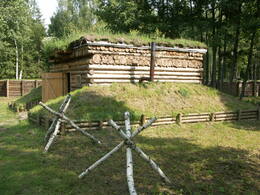
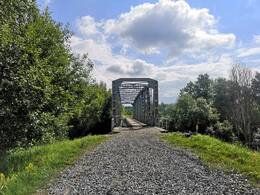

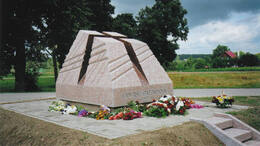
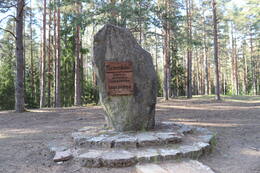
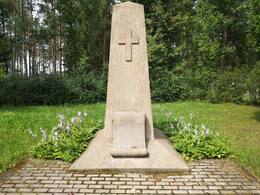
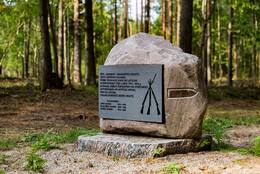
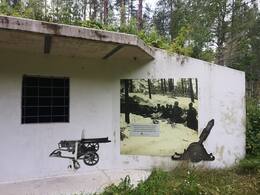
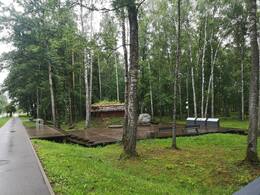
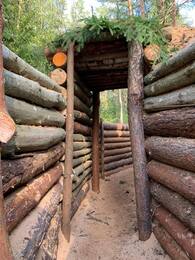
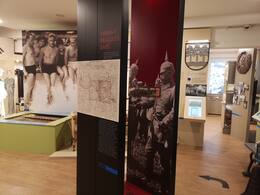
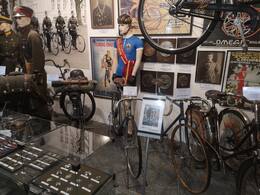
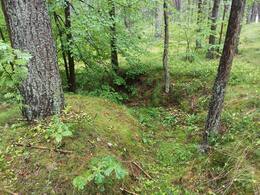
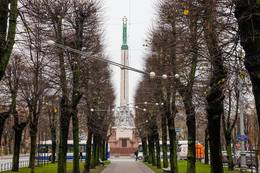
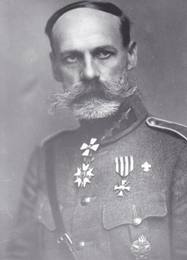
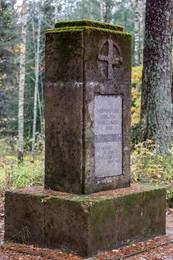
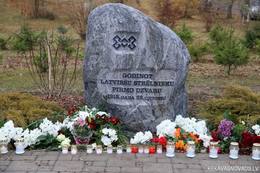
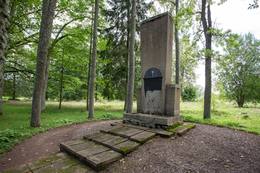
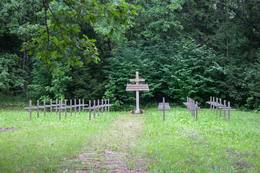
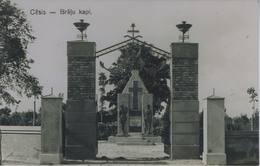
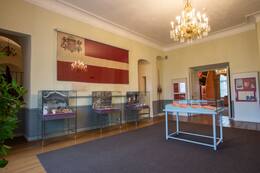
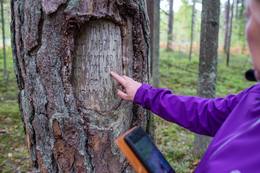
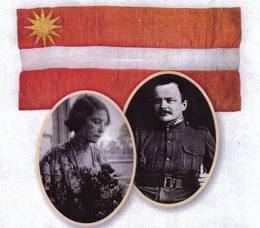
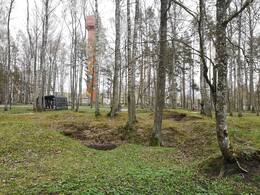
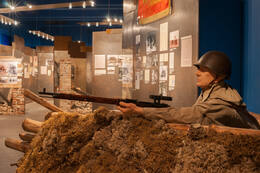
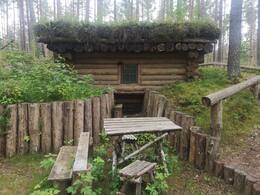
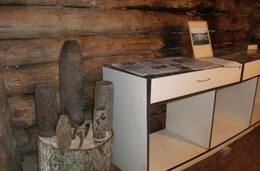
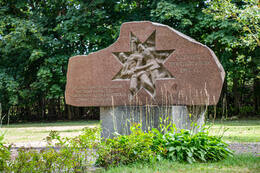
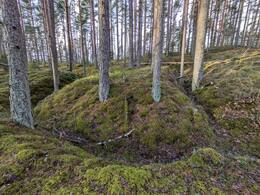
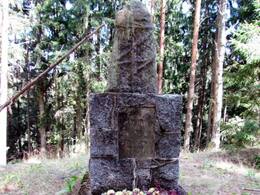
Прошу внести исправления в список павших латвийских стрельцов. Брат моей бабушки Индрикис Кадикис, сын Екаба, умер 16 января 1917 года, родился в Снапеле.